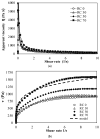Printability and Thermophysical Properties of Three-Dimensional-Printed Food Based on "Cochayuyo" Durvillaea antarctica Seaweed Flour
- PMID: 38928767
- PMCID: PMC11203116
- DOI: 10.3390/foods13121825
Printability and Thermophysical Properties of Three-Dimensional-Printed Food Based on "Cochayuyo" Durvillaea antarctica Seaweed Flour
Abstract
This research assessed the feasibility of adding Cochayuyo seaweed flour (at 30, 50, and 70% levels) to rice flour-based paste to improve its 3D printing quality. The paste's rheological properties, printing quality, texture profile, thermal properties, and color of 3D-printed foods were explored. Results showed that pastes with Cochayuyo addition exhibited shear-thinning behavior, and viscosity increased with increased Cochayuyo concentration. Viscoelastic properties and a Texture Profile Analysis (TPA) revealed that Cochayuyo improved mechanical strength and made the paste easier to flow, improving printed food's extrudability, fidelity, and shape retention, which was better observed in RC50 and RC70 printed at 15 mm s-1. A differential scanning calorimetry (DSC) analysis showed a partial substitution of rice flour for Cochayuyo flour in the formulation. This increased the onset and melting peak temperatures and reduced the enthalpy of fusion. CIE color parameters a*, b*, and L* showed that Cochayuyo addition increased the color to yellow and red; however, lightness was considerably reduced. Therefore, Cochayuyo flour could have the potential to be used for the manufacture improvement of 3D-printed food with better rheological, mechanical, thermal, printing quality, and nutritional properties, making possible the exploitation of the native Cochayuyo seaweed, which is highly available in Chile.
Keywords: 3D food printing; cochayuyo; differential scanning calorimetry (DSC); printing capacity; rheology; texture profile.
Conflict of interest statement
The authors declare no conflict of interest.
Figures




References
-
- Liu Y., Tang T., Duan S., Qin Z., Li C., Zhang Z., Liu A., Wu D., Chen H., Han G., et al. Effects of sodium alginate and rice variety on the physicochemical characteristics and 3D printing feasibility of rice paste. LWT. 2020;127:109360. doi: 10.1016/j.lwt.2020.109360. - DOI
-
- Ranjan R., Kumar D., Kundu M., Chandra Moi S. A critical review on Classification of materials used in 3D printing process. Mater. Today Proc. 2022;61:43–49. doi: 10.1016/j.matpr.2022.03.308. - DOI
-
- Mantihal S., Kobun R., Lee B.B. 3D food printing of as the new way of preparing food: A review. Int. J. Gastron. Food Sci. 2020;22:100260. doi: 10.1016/j.ijgfs.2020.100260. - DOI
Grants and funding
LinkOut - more resources
Full Text Sources

